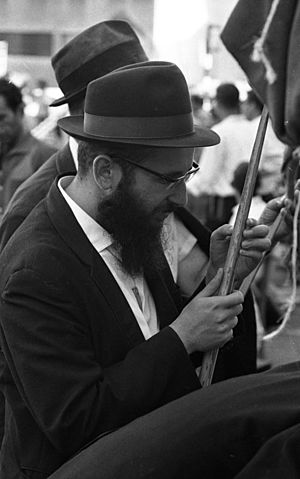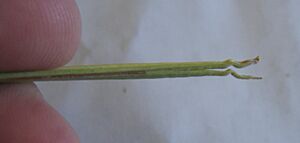Lulav facts for kids
A Lulav (pronounced loo-LAHV) is a closed frond from a date palm tree. It's one of the four special plants used during the Jewish holiday of Sukkot. The other three plants are the hadass (myrtle), aravah (willow), and etrog (citron). When the lulav, hadass, and aravah are tied together, people often just call them "the lulav."
Contents
Why Lulav is Used in Sukkot
The Torah, which is a holy Jewish text, tells people to use a lulav for the Sukkot holiday. This instruction is found in the Book of Leviticus:
Leviticus 23:40
- "And ye shall take you on the first day the fruit of goodly trees, branches of palm-trees, and boughs of thick trees, and willows of the brook, and ye shall rejoice before the LORD your God seven days."
Originally, the rule was to use the lulav and the other three plants for all seven days of Sukkot only when people were near the Holy Temple in Jerusalem. In other places, like the rest of the Land of Israel or outside of Israel, it was only required on the first day.
After the Temple was destroyed in 70 CE, a wise leader named Rabbi Yochanan ben Zakai made a new rule. He said that Jews everywhere should use the four plants for all seven days of the holiday. This was done to remember what was once done in the Temple.
Rules for a Kosher Lulav
Just like other items used for Jewish mitzvahs (commandments), a lulav must meet certain standards to be considered "kosher" (acceptable) for use.
A good lulav should be a straight, tightly closed frond from a date palm tree. Its leaves should be whole and lie close together. The top of the lulav should not be bent or broken.
The two middle leaves that grow together are called the tiyomet (pronounced tee-YOH-met), which means "twin." Ideally, these twin leaves should not be split at all. However, a lulav is still kosher if these middle leaves are not split more than about 3-4 inches. This rule is very important on the first day of Sukkot in Israel, and on the first two days outside of Israel. On the middle days of Sukkot (called Chol HaMoed), a split middle leaf is not a problem.
How the Lulav is Used
The term lulav also refers to the lulav itself when it's combined with two other plants: the aravah and the hadass. These three are tied together.
To perform the mitzvah, you hold these three plants in one hand and the etrog in the other. Then, you bring your hands together and wave the plants in all four directions (north, south, east, west), as well as up and down. This waving shows that God is in charge of everything in the world. It's also a way to pray for enough rain for all the plants on Earth in the coming year.
Even though all four plants are used, the blessing said before using them only mentions the lulav. This is because the lulav is the largest and most noticeable of the four plants.
In Jewish tradition, each of the four plants is said to represent a part of the human body. The lulav stands for the spine, the myrtle for the eyes, the willow for the lips, and the etrog for the heart.
Images for kids
See also
 In Spanish: Lulav para niños
In Spanish: Lulav para niños





